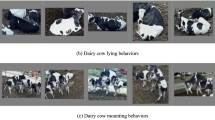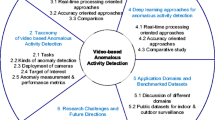Abstract
Poultry farms across the world house animals such as cows, sheep’s, pigs and hen These farms are the places from where the market gets meat, eggs, wool and other animal products which are used in our daily lives. But sometimes the business of the farms is severely hit primarily due to poultry animals catching diseases or these animals succumbing to injuries caused due to fighting each other. The identification of such animals showing unusual characteristics or behavior is necessary. We through our paper use deep learning concepts to help the poultry owner to identify these unusual characteristics in a sheep. Some of the characteristics that our paper identifies are skinny, redness, non-aggression, aggression, beefy and foraging. Our paper makes use of a video, shot from a camera and the implementation of a sequential model as well as make use of the SSD algorithm to identify and characterize the sheep’s depicted in the video. The sequential model is trained using the training dataset which contains static images of sheep’s and the attribute/characteristics depicted by those sheep’s that are stored in a CSV file. The testing dataset contains the images that are extracted from the input video as frames. The testing dataset is passed through the sequential model to get the characteristics/attributes depicted by the sheep in each frame and store those characteristics/attributes in a CSV file. The SSD algorithm is trained on identifying the various animals and not only does it display the name of the animal detected, it displays the confidence percentage of the animal as well, in our paper it is used for identifying sheep. The above stated algorithm also creates a border around the identified sheep such that it can be used for tracking purposes during the entirety of the video. The SSD algorithm also takes in the attributes depicted by these frames and displays them along the border which identifies the sheep. The accuracy is compared with YOLO algorithms and shows 3 to 6% improvement on prediction rate.














Similar content being viewed by others
References
America: Equine practice (2013) 8:71–89. https://doi.org/10.1016/s0749-0739(17)30467-4
Andavarapu N, Vatsavayi VK (2017) Wild-animal recognition in agriculture farms using W-COHOG for agro-security. Int J Comput Intell Res 13(9):2247–2257
Blackshaw JK (2012, 2013) Behavioural profiles of domestic animals—horses. Archived from the original (2012, 2013)
Browning E, Bolton M, Owen E, Shoji A, Guilford T, Freeman R (2018) Predicting animal behaviour using deep learning: GPS data alone accurately predict diving in seabirds. Methods Ecol Evol 9(3):681–692
Chen Y, Jiang H, Li C, Jia X, Ghamisi P (2016) Deep feature extraction and classification of hyperspectral images based on convolutional neural networks. IEEE Trans Geosci Remote Sens 54(10):6232–6251
Chen C, Zhu W, Ma C, Guo Y, Huang W, Ruan C (2017) Image motion feature extraction for recognition of aggressive behaviors among group-housed pigs. Comput Electron Agric 142:380–387
Farooq M, Sazonov E (2017) Feature extraction using deep learning for food type recognition. In: International conference on bioinformatics and biomedical engineering, pp 464–472. Springer, Cham
Huber-Eicher B, Sebö F (2001) The prevalence of feather pecking and development in commercial flocks of laying hens. Appl Anim Behav Sci 74(3):223–231
Kalueff AV, Tuohimaa P (2004) Experimental modeling of anxiety and depression. Acta Neurobiol Exp 64(4):439–448
Krizhevsky A, Sutskever I, Hinton GE (2012) Imagenet classification with deep convolutional neural networks. In: Advances in neural information processing systems, pp 1097–1105
Lumeij JT, Hommers CJ (2008) Foraging ‘enrichment’as treatment for pterotillomania. Appl Anim Behav Sci 111(1–2):85–94
McDonnell SM (1992) Normal and abnormal sexual behavior. Vet Clin N Am Equine Pract 8(1):71–89
Nguyen H, Maclagan SJ, Nguyen TD, Nguyen T, Flemons P, Andrews K, Ritchie EG, Phung D (2017) Animal recognition and identification with deep convolutional neural networks for automated wildlife monitoring. In: 2017 IEEE international conference on data science and advanced Analytics (DSAA), pp 40–49. IEEE
Norouzzadeh MS, Nguyen A, Kosmala M, Swanson A, Palmer MS, Packer C, Clune J (2018) Automatically identifying, counting, and describing wild animals in camera-trap images with deep learning. Proc Natl Acad Sci 115(25):E5716–E5725
Pickett BW, Squires EL, Voss JL (1981) Normal and abnormal sexual behavior of the equine male. General series-Colorado State University Experiment Station (USA), Springfield
Posage JM, Marder A (2013) Excessive barking. Accessed from https://www.PetPlace.com
Rajagopal RD, Murugan S, Kottursamy K, Raju V (2019) Cluster based effective prediction approach for improving the curable rate of lymphatic filariasis affected patients. Clust Comput 22(1):197–205
Reinhardt V, Reinhardt A, Eisele S, Houser D, Wolf J (1987) Control of excessive aggressive disturbance in a heterogeneous troop of rhesus monkeys. Appl Anim Behav Sci 18(3–4):371–377
Saravanan M, Aramudhan M, Pandiyan SS, Avudaiappan T (2019) Priority based prediction mechanism for ranking providers in federated cloud architecture. Clust Comput 22(4):9815–9823
Simonyan K, Zisserman A (2014) Very deep convolutional networks for large-scale image recognition. ArXiv preprint arXiv:1409.1556
Stuhlsatz A, Lippel J, Zielke T (2012) Feature extraction with deep neural networks by a generalized discriminant analysis. IEEE Trans Neural Netw Learn Syst 23(4):596–608
Trnovszký T, Kamencay P, Orješek R, Benčo M, Sýkora P (2017) Animal recognition system based on convolutional neural network. Digital Image Process Comput Graph 15(3):517–525
Wicht B (2017) Deep learning feature extraction for image processing thesis. Ph.d., Department of Informatics, University of Fribourg, (Switzerland)
Author information
Authors and Affiliations
Corresponding author
Ethics declarations
Conflict of interest
The authors declare that there is no conflict of interest regarding the publication of this paper.
Ethical approval
This article does not contain any studies with animals performed by any of the authors.
Informed consent
All the authors are aware and well informed about this submission.
Additional information
Communicated by V. Loia.
Publisher's Note
Springer Nature remains neutral with regard to jurisdictional claims in published maps and institutional affiliations.
Rights and permissions
About this article
Cite this article
Thenmozhi, M., Saravanan, M., Kumar, K.P.M. et al. Improving the prediction rate of unusual behaviors of animal in a poultry using deep learning technique. Soft Comput 24, 14491–14502 (2020). https://doi.org/10.1007/s00500-020-04801-2
Published:
Issue Date:
DOI: https://doi.org/10.1007/s00500-020-04801-2




